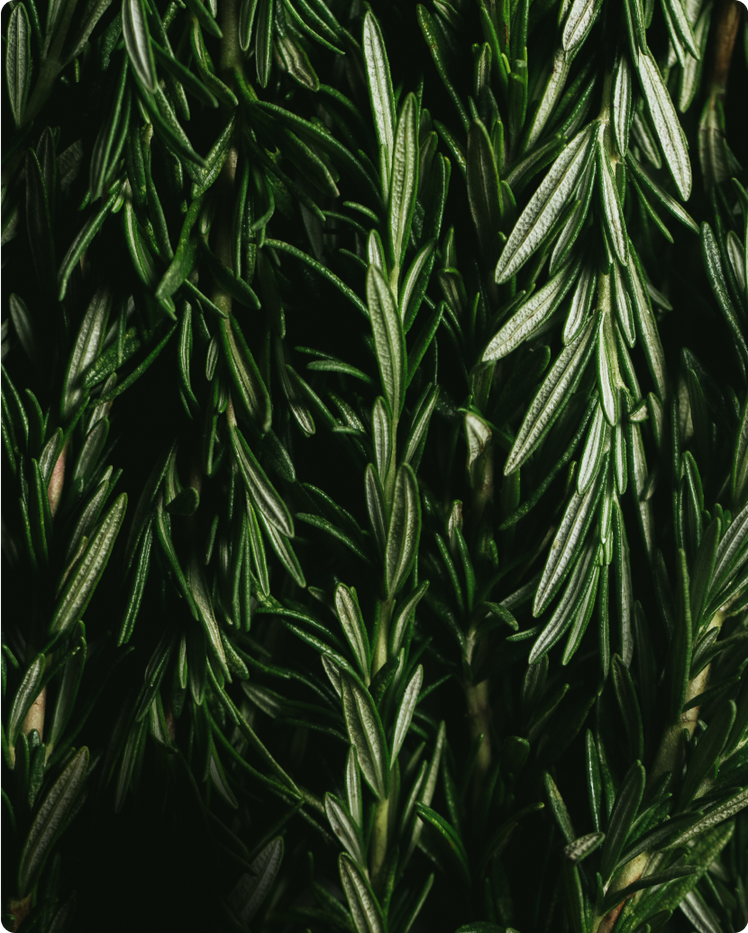About the Oil
Rosemary essential oil is distilled from the fragrant leaves and flowering tops of Rosmarinus officinalis (also known botanically as Salvia rosmarinus). With its fresh, herbaceous, and slightly camphoraceous scent, rosemary has earned a place in both ancient healing traditions and modern-day aromatherapy. It’s celebrated for its ability to enliven the mind, awaken the senses, and support a clear, focused mental state.
Why You Would Use Rosemary Essential Oil
-
To help increase alertness, concentration, and mental clarity
-
As an invigorating scalp treatment that promotes healthy-looking hair
-
To support memory retention and reduce brain fog
-
For soothing physical tension or muscle fatigue
-
To help purify the air with its fresh, green aroma
Clinical Findings
| Study | Participants & Methods | Key Results | Reference |
|
Cognitive performance |
Human subjects exposed to rosemary aroma |
Improved speed and accuracy in memory tasks |
Moss et al., 2012 |
|
Stress modulation |
Adults evaluated via aroma exposure and mood scale |
Rosemary aroma decreased anxiety and increased alertness |
Moss et al., 2012 |
|
Hair growth stimulation |
Individuals with androgenetic alopecia using rosemary oil |
Comparable results to minoxidil over 6 months, with less scalp itching |
Panahi et al., 2015 |
Behind The Science
Rosemary essential oil is rich in powerful phytochemicals like 1,8-cineole, camphor, and α-pinene—compounds shown to stimulate cognitive function, enhance circulation, andreduce inflammation. When inhaled, these compounds interact with the brain’s limbic system, supporting memory, mood, and alertness.
Research has also shown rosemary oil may influence cognitive activities which plays a key role in learning and memory. Topically, it supports healthy microcirculation, which may be one reason it’s traditionally used in hair and scalp care. Also make it a valuable addition to natural cleaning and skin-supportive blends.
How and Where It Grows
Rosemary thrives in Mediterranean climates with warm, dry conditions and well-drained soil. The plant is a member of the mint family and produces tough, needle-like leaves packed with essential oil glands. Rosemary oil is steam distilled, capturing the sharp, green aroma and the potent therapeutic properties of the plant.
Use in Ancient Medicine
Since antiquity, rosemary has symbolized remembrance and protection. The ancient Greeks and Romans burned rosemary in temples and wore garlands of it to enhance memory. In medieval Europe, it was carried in sachets to ward off illness, and it has long been steeped into herbal tonics for everything from digestion to hair growth.
Symbolism
Rosemary represents clarity, remembrance, and resilience. It's often associated with ceremonial practices—both joyful and solemn—as a way to honor the past while staying present in the moment. Its vibrant, energizing aroma encourages forward movement, focused thought, and mental clarity.
INFORMATION provided is intended for informational purposes only and is not meant to diagnose, treat, cure, or prevent any disease. Statements have not been evaluated by Health Canada or the FDA. Please consult a qualified healthcare provider before using essential oils for therapeutic purposes.
References
- Moss, M., Cook, J., Wesnes, K., & Duckett, P. (2012). Aromas of rosemary and lavender essential oils differentially affect cognition and mood in healthy adults. Ther Adv Psychopharmacol, 2(3), 103–113.
- Panahi, Y., Taghizadeh, M., Marzony, E. T., & Sahebkar, A. (2015). Rosemary oil vs minoxidil 2% for the treatment of androgenetic alopecia: a randomized comparative trial. Skinmed, 13(1), 15–21.
- Soliman, F.M., El-Kashoury, E.A., Fathy, M.M. and Gonaid, M.H. (1994), Analysis and biological activity of the essential oil of rosmarinus officinalis l. from egypt. Flavour Fragr. J., 9: 29-33. https://doi.org/10.1002/ffj.2730090107
- Tisserand, R., & Young, R. (2014). Essential Oil Safety (2nd ed.). Churchill Livingstone Elsevier.

